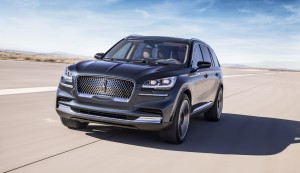
Joe Hinrichs, Ford president of Global Operations, left, and Chicago Mayor Rahm Emanuel shake hands after announcing a $1 billion investment in the Chicago Assembly Plant.
This story has been updated with new information.
Ford Motor Co. will announce plans to invest $1 billion to expand its SUV operations in Chicago, TheDetroitBureau.com has learned, in the process hiring 500 workers.
The news comes the same week as General Motors has begun handing out pink slips to approximately 4,000 of its white-collar staff as part of what will be a $6 billion restructuring. Ford is also expected to announce cuts of its own as it moves forward with an $11 billion global restructuring, with details impacting U.S. operations scheduled to be announced by spring.
The fact that Ford is hiring now, but that it could subsequently let other workers go, reflects the dramatic changes sweeping through the auto industry, especially in the U.S., where buyers by the millions have shifted from passenger cars to light trucks like those being built by the second-largest domestic automaker at its Windy City plant.
At the Chicago Auto Show this morning Ford will announce plans to invest $1 billion at the Windy City complex which includes both the Chicago Assembly and Stamping Plants. The move will be used to add “advanced manufacturing technologies,” according to company sources, and also to train workers to both boost plant efficiency and improve quality.
“We’re making these investments because our company believes in American manufacturing and good paying jobs for American workers,” said Joe Hinrichs, Ford president of Global Operations.
(Ford unveiled its new Explorer Police Interceptor model. Click Here for the story.)

Ford is expanding the Explorer line-up to include a new high-performance ST model and a fuel-efficient hybrid.
In the process, Ford also plans to add about 500 new jobs at the two adjacent factories.
Chicago Mayor Rahm Emanuel praised Ford’s decision saying it “benefits Ford’s health and Chicago’s health as well.” The State of Illinois and city of Chicago helped Ford make the $1 billion investment using a three-pronged program that included $200 million in infrastructure improvements around the plant as well as the purchase of hundreds of new Ford Police Interceptors.
Not all the money will go into machine technology, however, Ford planning to devote $40 million of the investment to make the plants “better places to work” by improving lighting, bathroom and cafeterias. It will also upgrade security in plant parking lots.
The Chicago Assembly Plant opened in 1924 and is Ford’s longest continuously running facility in the country. It remains among its most important as the production source for the critical Explorer model. The upgrades will allow Ford to expand capacity for two all-new models, the Explorer Police Interceptor and the Lincoln Aviator.
Ford has traditionally dominated the market for police vehicles and hopes to increase its share with the addition of the Interceptor it unveiled at the North American International Auto Show in Detroit last month.
The covers were first lifted on the Aviator at the Los Angeles Auto Show last November. The big, three-row SUV is expected to become a critical addition to the long-struggling Lincoln brand and has won strong initial praise, prompting Ford to want to ensure it can build enough when the SUV starts rolling into showrooms.

The new Ford Police Interceptor Utility provides a slew of new technology as well as energy savings.
SUVs, primarily in crossover form, are experiencing explosive growth and, along with pickups and vans, now account for two-thirds of the U.S. new vehicle market.
(Click Here for a look at the new Lincoln Aviator.)
That shift has led the industry to rapidly downplay traditional sedans and coupes. Ford is essentially pulling out of the passenger car market but for its ever-popular Mustang model. It has, in turn, ramped up production of trucks as diverse as the Escape, Explorer and F-150, while adding new models like the Lincoln Aviator, Ford Ranger and upcoming Ford Bronco.
Ford isn’t alone. Fiat Chrysler Automobiles has also pulled back on passenger car production, shifting resources to trucks. The automaker is expected to soon announce plans to add a factory – and jobs – CEO Michael Manley confirmed last month.
General Motors is making a shift of its own, with six passenger car lines going away this year, models as diverse as the Chevrolet Cruze and Cadillac CT-6. In the process, however, it has “unallocated” three plants which is expected to result in their closure by year-end. That has generated a firestorm of controversy, especially as one of the company’s most promising new models, the Chevrolet Blazer SUV, is being built in Mexico.
GM this week began handing out pink slips to about 4,000 hourly workers as part of a broad restructuring. Thousands of others have already taken voluntary packages, while contractors have also been terminated. The $6 billion project is eventually expected to reduce GM’s workforce by around 14,000, though President Mark Reuss this week told TheDetroitBureau.com that with many factory workers opting to retire, only about 100 jobs will be lost on the plant side.
Other blue-collar workers are being offered the opportunity to move to existing plants, including the Flint factory that this week launched the new Chevrolet Silverado HD pickup. It is expanding capacity 25% with the new model.
(For a closer look at the new 2020 Chevrolet Silverado HD, Click Here.)
Industry analysts expect to see more changes as automakers move to adopt to the SUV boom and other changes, and Ford could announce job cuts of its own in the next few months as part of its own restructuring.

